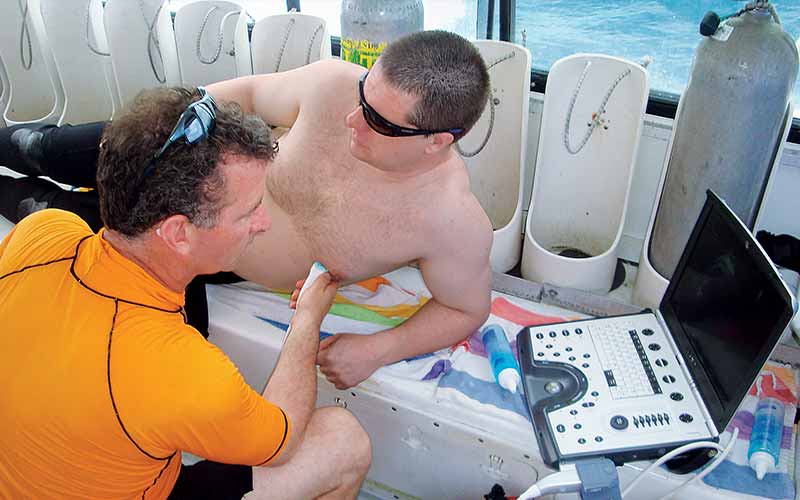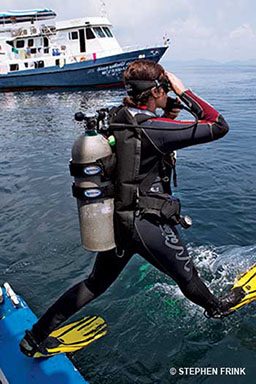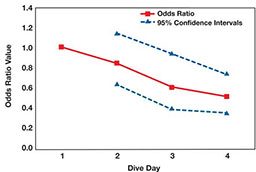While decompression sickness (DCS) is relatively rare, it receives much attention because its effects can be severe. Divers often find themselves completing multiple dives over a short period, such as on a dive vacation. A very natural concern is whether repeated, daily diving increases or decreases DCS risk.
Adaptation to natural exposure is known as acclimatization. It is possible that repetitive diving could alter the degree of decompression stress experienced either through positive acclimatization (protective) or negative acclimatization (sensitizing and increasing the risk). Evidence of positive acclimatization to repetitive diving has been reported in a small number of animal studies, but data from the limited work with human subjects are less clear.
Few divers will repeat the exact same dive profile or profiles on a daily basis. In practice, the first dives of a series, particularly following a period of not diving or upon arrival at an unfamiliar area, are often relatively conservative in comparison with later dives. This means that any change in the risk over the series may be due to factors other than the repetitive exposure, making it difficult to study the effect in observational studies. A greater degree of control is needed to gain insight.
Our team recently completed a study of four days of identical, daily diving to remove the confounding variable of evolving dive profiles. We used intravascular bubbles as the indicator of decompression stress. The goal was to see if the postdive bubble grade scores changed over the series. This article summarizes the research fully described in the peer-reviewed paper.1

Methods
Sixteen healthy, experienced and reasonably fit male divers participated. All had avoided diving for at least one week prior to the study. Each diver completed one air dive on each of four consecutive days, each to 60 feet of seawater with a bottom time of 47 minutes in a fairly calm, temperate ocean environment. The divers exercised continuously at a moderately heavy rate while at the bottom and wore wetsuits for thermal comfort. While the depth-time profile of the dives was not aggressive, the continuous exercise (at a higher level than most divers would maintain) increased the inert gas uptake. We have found through previous studies that this dive tends to generate substantial bubble loads with minimal risk of DCS.

Dive profiles and diver heart rates were monitored continuously and recorded electronically for all dives. Postdive monitoring employed two-dimensional ultrasound to allow visual study of bubbles in the heart chambers. Blood (and bubbles) in the right heart is pumped to the lungs, and blood (and bubbles) in the left heart is pumped throughout the body. Monitoring was conducted at 20-minute intervals for two hours. The bubble presence was scored on an eight-point scale by teams of two experienced technicians.
The bubble grade scale we used is as follows: 0 = no bubbles; I = occasional bubbles; II = at least one bubble every four cardiac cycles; III = at least one bubble every cardiac cycle; IVa = at least one bubble per square centimeter; IVb = at least three bubbles per square centimeter; IVc = almost complete whiteout, but individual bubbles can still be discerned; and V = whiteout in which individual bubbles cannot be discerned. Scores were recorded while the subject remained at rest and following a standardized series of arm and leg movements. The highest score for each rest/movement cycle was used in the analysis as the peak grade for the cycle.
The bubble grades were evaluated statistically to determine if the likelihood (relative odds) of developing relatively higher or relatively lower postdive bubble grades were similar across the days of the study.
Results

The chart depicts the relative odds across the dive days. Day 1 is described as the referent day, with the odds arbitrarily set at 1.0. The odds of having a relatively higher bubble grade were lower on each successive day. The odds of having a relatively higher bubble grade on the fourth sequential day of diving were half the odds of having a relatively higher bubble grade on the first day. The dashed lines show the confidence intervals, which depict the numerical range in which there is a high level of confidence of including the “true” values (which a small sample size cannot be expected to pinpoint with complete accuracy).
Discussion
Although bubbles do not equate to DCS, they do represent decompression stress. The main finding of this study is that four consecutive days of identical daily diving can produce a progressive reduction in measured postdive bubble grades consistent with positive acclimatization. The controlled nature of the dive series was important to identify the pattern of change. The effect could easily be masked in a less-controlled dive series. In fact, any margin of safety provided by acclimatization can undoubtedly be undone by diving less conservative profiles on subsequent days. While acclimatization may offer some protective benefit, thoughtful profile choices are necessary to control the overall risk.

The mechanism of acclimatization to decompression stress is unknown. It could involve reduced bubble formation or reduced physiological response to any bubbles formed. It could be that asymptomatic (“silent”) bubbles produced in tissues after decompression are responsible for a form of protective preconditioning. The question of mechanisms requires further study since, if fewer bubbles do form as part of the acclimatization, the pressure for further acclimatization would be reduced. There may be subtle but complex relationships in play.
The first limitation of our study is that it represented only four days of single dives. It remains to be seen whether longer or more complicated dive series have similar effects. The second limitation is the inability to correlate the change in decompression stress indicated by intravascular bubbles with an absolute change in DCS risk. It remains reasonable to accept, though, that the presence of fewer bubbles is desirable.
In summary, our research helps to resolve a long-open question by showing that repetitive diving can, at least in the circumstances we studied, reduce bubble formation, representing what is likely a positive acclimatization to diving. Further work is required to determine if the response holds with more complicated dive series and how these changes affect the absolute risk of DCS.
Reference
- Zanchi J, Ljubkovic M, Denoble PJ, Dujic Z, Ranapurwala SI, Pollock NW. Influence of repeated daily diving on decompression stress. Int J Sports Med. 2013; DOI 10.1055/s-0033-1334968.
© Alert Diver — Q3 Summer 2013